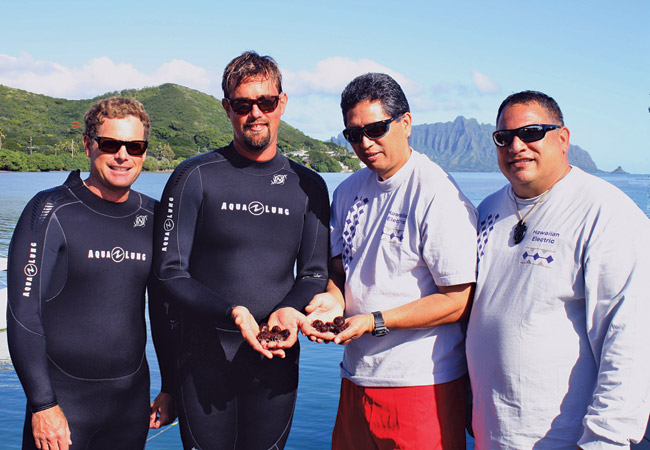Tiny, Prickly Sea Urchins A Valuable Weapon In Bay’s Algae War

Baby sea urchins, held by Hank Lynch (second from left) of The Nature Conservancy and Robert Kahawaii of Hawaiian Electric Co. are key to the nonprofit TNC’s plan to remove invasive algae from Kaneohe Bay – combined with ‘vacuuming’ the coral beds via Super Suckers. Also on hand are Brian Nielson (far left) of the state Aquatic Resources Division, which raises the urchins, and HECO employee John Lu’uwai of Kahaluu. Photo from HECO.
Those spiky wana have everybody excited. With the success of a recent experiment in Kaneohe Bay, a public-private partnership is under way to raise and release even more sea urchins into the algae-clogged bay to rescue the coral reefs.
“The support from businesses and community partners like Hawaiian Electric Co. is vital to the success of restoring Kaneohe Bay and our goal of clearing 60 acres of reef by 2015,” said The Nature Conservancy executive director Suzanne Case.
HECO recently donated $25,000 to TNC to help it restore all 2,250 acres of the He’eia ahupua’a, mountain to sea, bringing the company’s total contribution to $75,000 for the effort. Also involved is the state Division of Aquatic Resources, which is raising native Collector Sea Urchins in tanks at its Anuenue Fisheries Research Center and then releasing them into the bay.
The urchins happily gobble up the aggressive, non-native algae floating by and have proved to be a real winner, even after the advent of the state’s “Super Sucker” underwater vacuum, followed by TNC’s Super Sucker II. Two divers equipped with a 100-foot hose feed the invasive growth into the two vacuums, which can consume up to 1,000 pounds of algae an hour, or 20,000 pounds per day. The algae is then dried and given to local farmers to use as fertilizer – similar to TNC’s Maunalua Bay project.
Reef managers like state biologist Tony Montgomery found that invasive algae were reappearing within months of TNC divers’ hands-on vacuuming efforts in 2012 to relieve the smothered corals. But when 1,200 urchins were placed in a nearby reef patch in 2013, they performed like gardeners weeding their fields, and the algae was limited to only 3 percent cover for the entire year.
“What this shows,” explained TNC’s local marine programs director Kim Hum, “is that you can use the Super Suckers to reduce the density of the alien algae, and then use the urchins to keep it down.”
Also working against reef health are 1) the flow of sediments and nutrients into the bay, and 2) not enough plant-eating fish to eat the invaders – a result of overfishing for herbivores like parrotfish, surgeonfish and sea urchins.
TNC also is looking mauka to the source of bay pollutants.
“We need to restore the He’eia wetland system to reduce the flow of sediment into the bay,” said Case. To that end, TNC is partnering with area groups to restore the ahupua’a’s cultural and ecological health. Planned are volunteer efforts such as algae pulls at Paepae o He’eia fishpond, farming and taro planting with Kako’o ‘Oiwi, and educational events with KEY Project, Kama’aina Kids an Kamehameha Schools.





